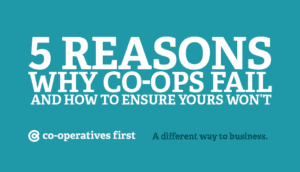Very few people look forward to attending an Annual General Meeting (AGM). Unless you’re part of a small employee-owned co-operative, the percentage of member shareholders at your local co-op’s AGM is probably low. You may even not attend. (For shame! Just kidding.) Although a lot of people loyally use their co-op, not everyone is interested in all that process and procedure stuff — which can lead to an empty AGM.
This is normal. Folks who start and run co-ops often expect AGMs to have low attendance. To avoid issues with making quorum, the minimum number of members (or voting shareholders) required at an AGM is often set very low. For example, Calgary Co-op – a large consumer co-operative with over 440,000 members – only requires 50 members for its AGM.
Here are 3 reasons members might not show up at an AGM and what you can do to increase attendance next year.
1. The co-op is doing well
People speak out when they’re not happy, but rarely have something to say when things are going well. When members trust their board and the co-op’s management, they might take a pass on the AGM, knowing the business is in good hands.
So, if you have an empty AGM, don’t take it personally. You’re probably doing a good job and simply haven’t given people a reason to show up and complain.
That said, for a lot of co-ops, AGMs are often the only forum where members of the co-op can come together, ask questions, and share their thoughts on the co-op’s operations. So, if there’s something happening that people don’t like, expect to get a larger turn out at your AGM.
What can I do?
What can you do to manage the two extremes? In short, don’t be complacent – communicate and engage with members continuously.
To engage, create feedback channels and respond to feedback quickly, honestly and with authenticity. Plus, provide incentives to engage by rewarding those that do.
Regular communication to members is also essential. Try to keep your message focused on the incentives that brought each member to the co-op in the first place. No doubt, your co-op provides value to its owners in many ways. But first and foremost, it serves the owner-member’s self interest. Focus on that.
Stocksy United, a platform stock photography co-operative, can communicate with its members in cool ways on a regular basis. It uses message boards to allow members to express their ideas and opinions, and assigns executive members to answer questions and build relationships.
Remind your membership how you make their lives better. Play to this self-interest. Provide information pertinent to their interests and the decisions they need to make based on it. Quite frankly, that’s the point of a co-op: to serve the aligned self-interest of members in a way that benefits all those that opt to join.
Regular engagement shows membership they matter, their vote makes a difference and that you hear and care about their opinions. The result of solid engagement and communication is loyalty and growth.

2. People just aren’t interested
Not everyone has a passion for the policy and procedure discussed at AGMs, and that’s okay. Depending on the type and size of the co-op, the importance of membership engagement with policy and procedure will vary.
For consumer co-ops, for example, it’s much more important that members support the co-op financially by shopping or using its products/services. For some producer co-ops or employee-owned shops, every decision impacts the livelihood of each member. In those cases, the incentive and importance of participation in an AGM is far greater, meaning that they likely won’t have an empty AGM.
In most co-ops there’s a core group of supporters that ensure the organization is well-governed and held accountable. But you still want the broader membership engaged with the co-op.
What can I do?
Communicate with your membership regularly and consistently. Even though members’ participation in a co-op’s governance might be minimal, it’s important for both board and management to communicate and engage with members.
Show them the (hopefully positive) impact of decisions being made. Build trust by identifying with members’ interests, values, and whatever else brought them to the co-op in the first place. Remind members they have a voice and that voice matters to the wellbeing of the organization.
Engage members regularly through “member-only” perks and privileges, surveys and other feedback channels. Respect the feedback you get, show you heard those who made the effort to voice an opinion and reward them for their time and input.
Good communication and membership engagement will improve attendance at your AGMs, but more importantly, increase trust and loyalty in the co-op.

3. Members aren’t sure what their role is
Co-op members – especially in large consumer co-operatives – are often unclear what it means to be a ‘member.’
Costco, fitness centres, and country clubs all use the term ‘member’ to describe their clients and provide these clients with special treatment or promotions. The strategy is loyalty and it’s a smart one.
But it’s not the same as being a co-op member. Having a Costco membership doesn’t mean you own Costco. If you’re a member of MEC though, you do. Co-op members literally own shares in their co-op. And, despite holding a tiny part of MEC’s overall ownership, the shares you own give you the right to vote at MEC’s AGM.
Not surprisingly, when members of a co-op are unclear about their role in the business, they are less engaged. Lower engagement means fewer people at your AGM — or an empty AGM.
What can I do?
Different organizations offer unique solutions to this problem. Many Co-op stores as well as Vancity Credit Union promote the term “member-owners” to reinforce their difference. Housing co-operatives also emphasize their ownership model to set themselves apart from rental options.
Some, like a lot of credit unions, require membership to do business with them. Others, such as co-operative retailers, often don’t – anyone can shop but only members get discounts or patronage.
Spend time on a well thought-out onboarding and engagement strategy. Invest in member engagement and ensure members are equipped to shape and support your co-op. Without question, it will set your business apart from competitors.
The risk of complacency
At the end of the day, members need to be engaged and ready and willing to attend an AGM. Don’t be complacent. Actively engage your membership.
A top risk of low turnout at an AGM is a special-interest takeover of decision making and voting majority on a board. A takeover of the board by special interests can pose serious challenges to a co-op’s financial viability and its member-driven purpose. Don’t let that happen.
Need help planning your co-op’s AGM? Check out these resources on CoopCreator.ca or contact us.

 Written by
Written by 


